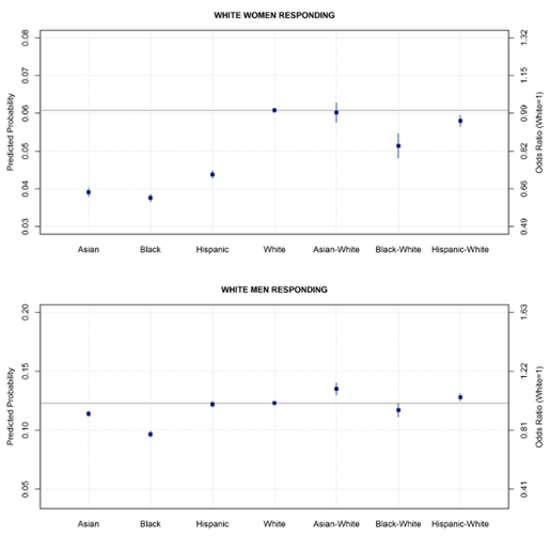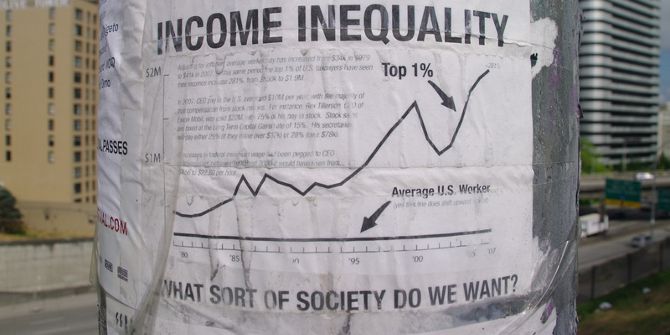 Over the last two decades, online dating has become progressively more acceptable – and popular. It has become so popular that preferences in the online dating market also reflect the reality of racial discrimination in the U.S. In new research, researchers Celeste Vaughan Curington and colleagues examine the experience of multiracial individuals in online dating. They find that there may be a “dividend effect” where multiracial men and women are preferred above all other groups, including Whites, an effect which could be attributed to cultural representations of multiracials as exotic, sexual, trendy, and attractive.
Over the last two decades, online dating has become progressively more acceptable – and popular. It has become so popular that preferences in the online dating market also reflect the reality of racial discrimination in the U.S. In new research, researchers Celeste Vaughan Curington and colleagues examine the experience of multiracial individuals in online dating. They find that there may be a “dividend effect” where multiracial men and women are preferred above all other groups, including Whites, an effect which could be attributed to cultural representations of multiracials as exotic, sexual, trendy, and attractive.
Researchers have long documented the existence of a racial hierarchy within the U.S. dating world, with White women and men the most preferred partners, Blacks the least preferred, and Asians and Latinos falling somewhere in between. While these findings echo the reality of persistent racial discrimination in U.S. dating and marriage markets, until now scholars have yet to address how the growing numbers of multiracial individuals navigate these complex dating hierarchies. In new research, we find evidence for a “dividend effect” in online dating, where multiracial Asian-White, Black-White and Latino-White men and women are preferred above all other groups, including Whites.
The 2000 U.S. Census marks the formal emergence of mark-more-than-one racial data collection practices – for the first time in U.S. history, individuals were able identify with more than one racial categorization. For many, this “right to choose” directly challenged a long U.S. history of federally assigning a minority identity to anyone of mixed racial parentage. A generation of scholars have since sought to assess whether the increase in multiracial identification reflects real changes in the U.S. racial status hierarchy.
Our research uses interactional data to test the social consequences of a White/minority multiracial status. Using 2003-2010 data from one of the largest dating websites in the United States, we examined nearly 6.7 million initial messages sent between heterosexual women and men and assessed whether White, Asian, Black and Latino monoracial (those that identify with a single racial group) daters were less likely, equally likely, or more likely to respond to initial messages sent from Black-White, Asian-White and Latino-White multiracial daters compared to messages from their same-race in-groups. We find that multiracial daters are treated very differently than single race daters, and, in fact, are afforded a preference premium in online dating.
As shown in Figures 1 and 2, three multiracial groups received what we refer to as a “dividend effect.” Asian-White women were viewed more favorably than any other group of women by White and Asian men, Asian-White and Hispanic-White men were also afforded “dividend” status by Asian and Hispanic women respectively. And Asian and Hispanic women responded more frequently to the multiracial men than to either their co-ethnic men or to Whites.
Figure 1

Figure 2

While White women, unlike White men, did not prefer any particular group of multiracial men to White men, they did respond to Asian-White and Latino-White men as frequently as to White men. The treatment of Black-White multiracial daters is distinct, however. White men and women are still less likely to respond to an individual who identifies as part Black and part White than they are to a fellow White. However, Black-White multiracial daters do receive a premium when compared to the treatment of their single race Black counterparts, who experience the heaviest rejection in online dating by Black and White daters. In other words, Black women and men and White women and Men respond more frequently to Black-White daters than to Black daters, though they privilege Whiteness over Black multiraciality.
But what precisely explains these differences? While it may be tempting to make the claim that the existence of this “dividend effect” in online dating indicates a lessening of racial discrimination experienced by White-non/White multiracials overall, I warn against using these findings to generalize to U.S. society at large. With its larger representation of mixed-race and single race minority daters, the online dating world is a unique context where physical appearance and sexualized/racialized perceptions of potential daters becomes particularly pronounced. For example, a generation of qualitative researchers found that multiracial women are subject to intense fetishization rooted in a long history of the mainstream American media representing mixed race women as exotic and sexually wanton. Indeed, a seemingly complimentary “dividend” effect in online dating masks potential stereotypes and power dynamics at play.
Second, changes in the U.S. 2000 Census sparked an increase in representation of multiracial individuals and mixed-race families in general. Marketers have taken keen interest in key demographic characteristics pertaining to this viable consumer population – namely, their relatively young age, high income earning potential and urban geographic concentration. In the case of multiracials, one-dimensional cultural representations influence how they may be perceived as “chic,” “trendy” and “post-racial.” This sentiment has been captured by Ron Berger, late CEO of a large U.S. marketing company in NYC, who stated that “today what’s ethnically neutral, diverse or ambiguous has tremendous appeal…Both in the mainstream and at the high end of the marketplace, what is perceived as good, desirable, successful is often a face whose heritage is hard to pin down”. In other words, these two unique race-specific representations of multiracials – as exotic and sexual and trendy and attractive- work together to reinforce the multiracial dividend effect in online dating.
Yet, there is likely another important dynamic at play. When we compare White-Asian, White-Black and White-Latino treatment in online dating to that of their single-race minority counterparts, it is apparent that a minority monoracial status remains penalized. Larger forces and contexts must therefore be considered alongside the multiracial dividend effect, such as the manner in which representations of lightness and Whiteness as desirable and attractive are thoroughly embedded in U.S. popular culture and internalized by individuals themselves. Thus, inequality in the form of colorism, or the systematic privileging of light skin over darker skin that spans back to colonialism, is likely to explain some of the more favorable treatment afforded to multiracials in online dating.
Overall, the existence of a Multiracial Dividend effect complicates previous studies on online dating that suggest a status hierarchy with groups neatly parceled out in order of desirability. For example, does Asian-White women’s heightened status in online dating somehow counter a history of U.S. fetishization of women of color and racial mixture? Or is this heightened status a result of this very dynamic? Further, will the multiracial dividend effect begin to counter some of the long-documented U.S. racial penalties outside of dating, such as marriage, education, work and housing? Our data is too context-specific to make such claims. However, what our research does clearly indicate is that there is a qualitatively significant difference between the treatment of self-identified mixed-race online daters and monoracial minority daters, but future research is needed to understand how the operation of this “dividend effect” is experienced by multiracials as well as whether it translates into other social settings in the United States where the distribution of valued resources is of paramount importance.
Featured image credit: Aleksandar Cocek (CC-BY-SA-2.0)
Please read our comments policy before commenting.
Note: This article gives the views of the author, and not the position of USAPP– American Politics and Policy, nor of the London School of Economics.
Shortened URL for this post: http://bit.ly/1LHkQMG
_________________________________
About the author
 Celeste Vaughan Curington – University of Massachusetts-Amherst
Celeste Vaughan Curington – University of Massachusetts-Amherst
Celeste Vaughan Curington is a doctoral student in the Sociology Department at the University of Massachusetts- Amherst. Her research interests include race and ethnicity, labor migration, and qualitative and quantitative methods. She is currently exploring African gendered migration and subsequent entrance into care economies in Portugal. Her other projects center on U.S. multiracial identity formation and the locational attainment of interracial households in Los Angeles County. Her recent work on multiracial identity has appeared in the journals American Sociological Review and Sociology of Race and Ethnicity.






